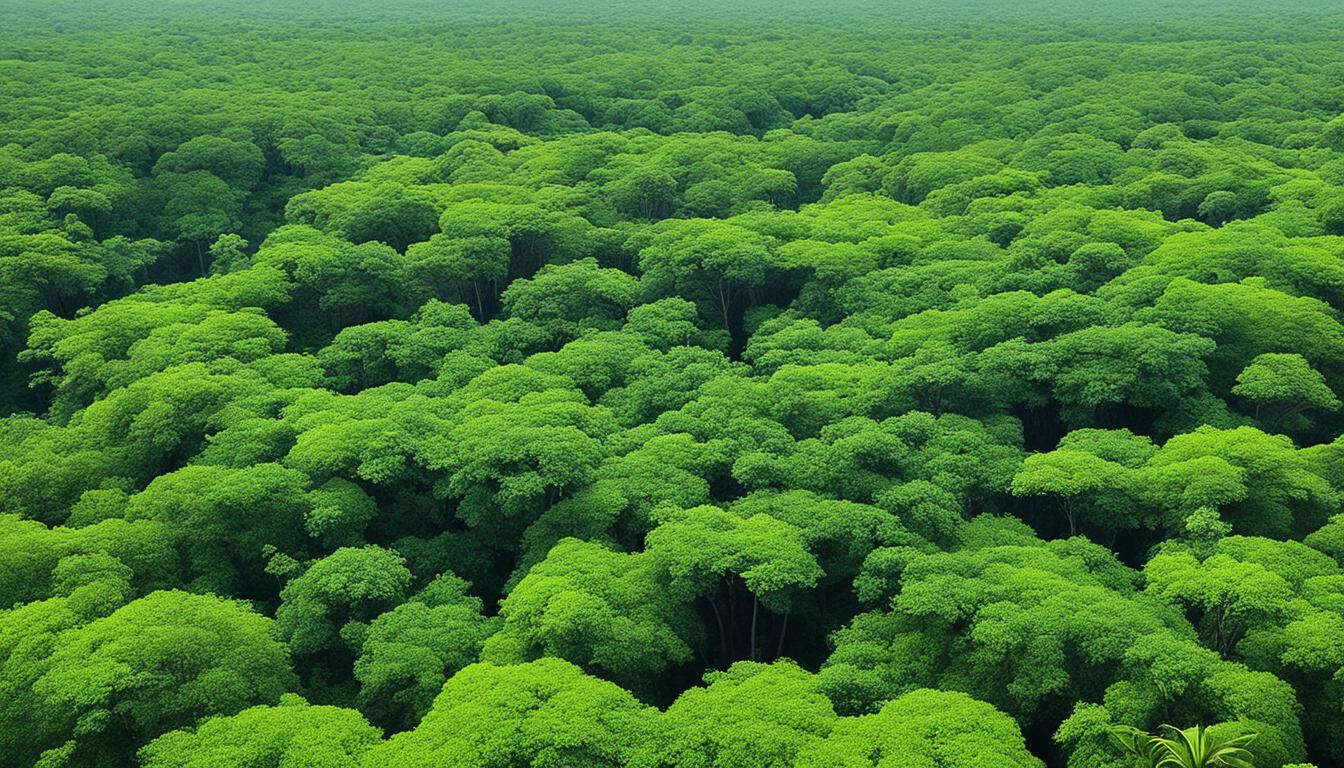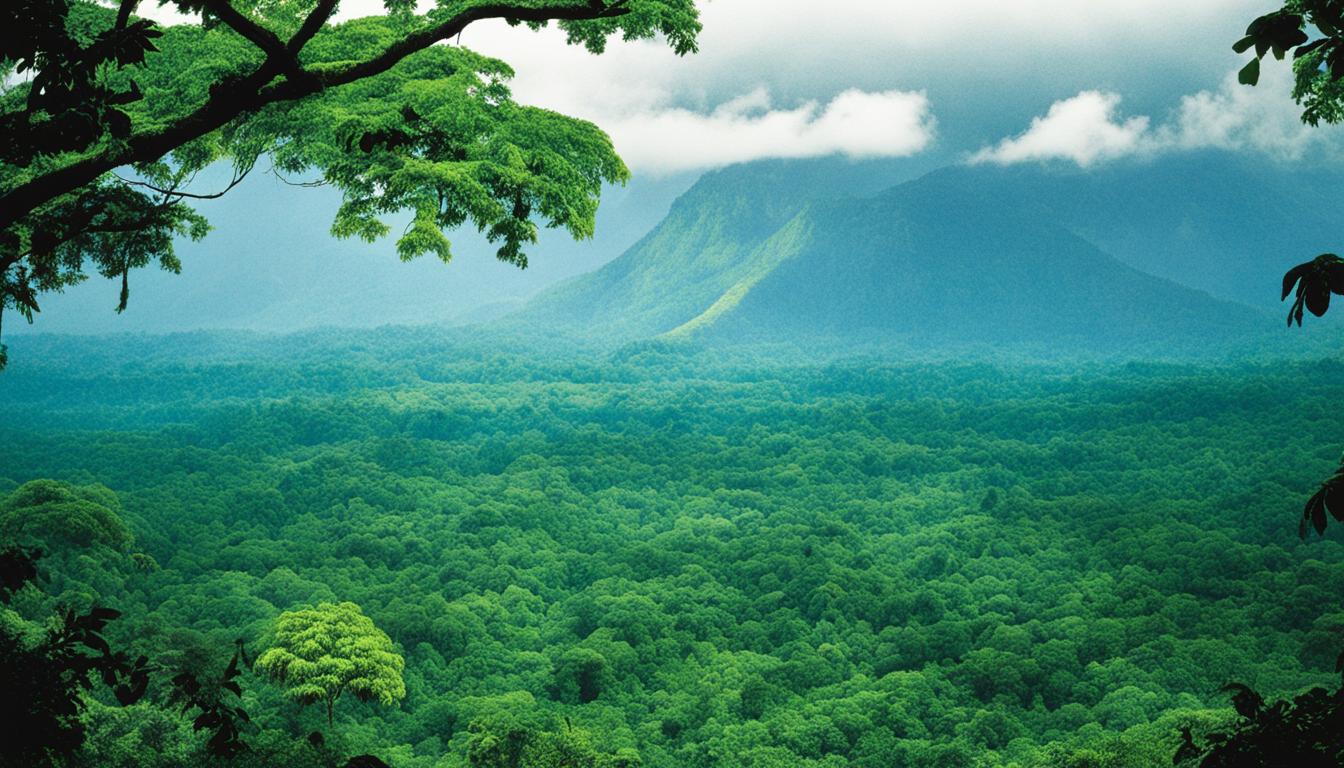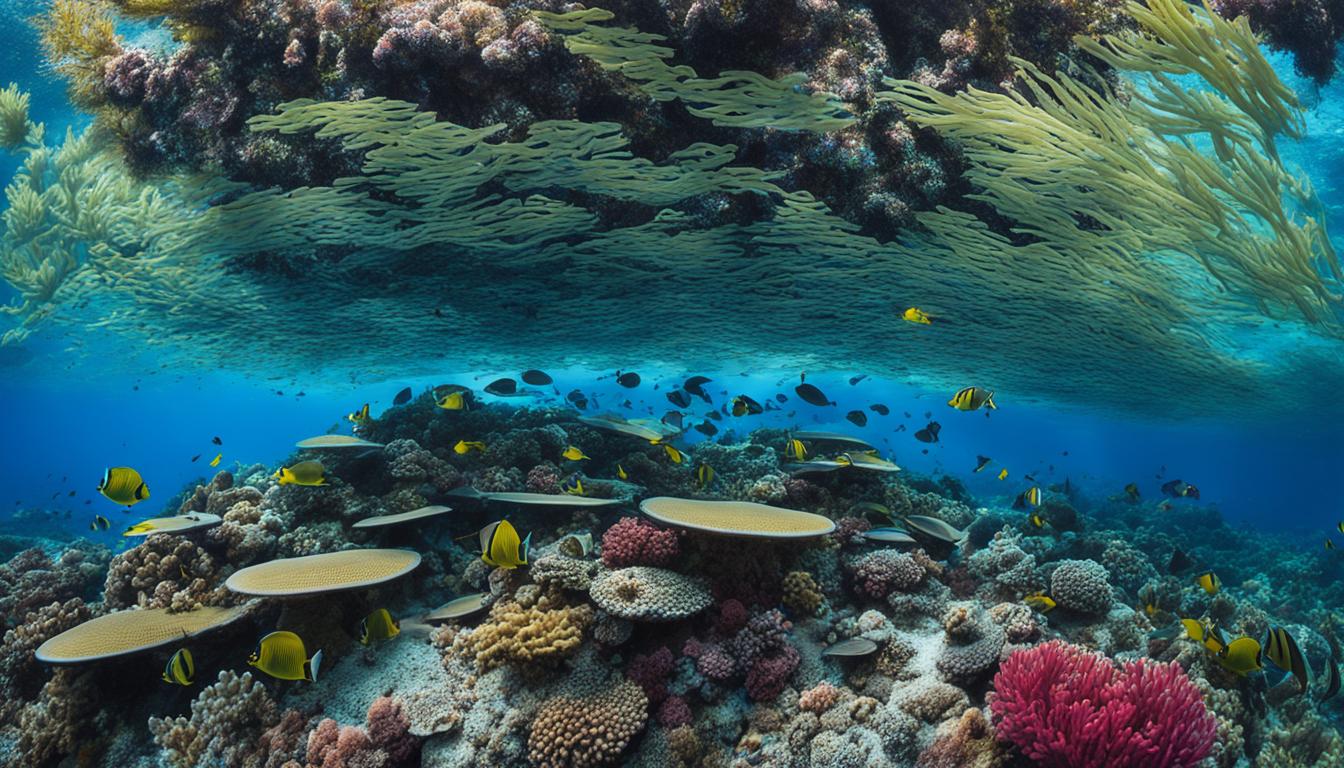Guinea Biodiversity: Animal and Plant Species and What Is Under Threat
Did you know that Guinea, a country located in West Africa, is home to an astounding array of flora and fauna? From lush rainforests teeming with unique animal species to expansive savannahs adorned with vibrant plant life, Guinea boasts remarkable biodiversity. However, the very diversity that makes Guinea’s ecosystems so special is now at risk due to various threats.
Endangered species, conservation efforts, and the delicate balance of flora and fauna in Guinea are crucial topics that need our attention. In this article, we delve into the various factors that endanger Guinea’s rich biodiversity and explore the steps that need to be taken to preserve these invaluable natural treasures.
Key Takeaways
- Guinea is home to an incredible variety of animal and plant species, making it a biodiversity hotspot.
- Various factors, including agriculture, hunting, logging, overfishing, and climate change, pose significant threats to Guinea’s flora and fauna.
- Conservation efforts and sustainable ecosystem management are crucial for safeguarding Guinea’s unique biodiversity.
- Preserving Guinea’s diverse habitats can also support ecotourism opportunities, benefiting both local communities and the environment.
- Addressing these threats and implementing effective strategies is essential for the long-term survival of Guinea’s flora and fauna.
Threats to Biodiversity in Guinea: Agriculture and Deforestation
The expanding human population in Guinea is driving the demand for new agricultural land, posing a significant threat to terrestrial biodiversity. This rapid expansion and the need for more agricultural space have led to increased deforestation, endangering the rich flora and fauna of Guinea.
Cash crops, such as cacao, play a significant role in deforestation. As agricultural lands are cleared for cacao plantations, valuable forest ecosystems are destroyed, disrupting the delicate balance of biodiversity. Similarly, the clearance of land for palm oil and rubber plantations presents a major threat to forests in Guinea.
Furthermore, the drainage and conversion of aquatic and wetland habitats for agriculture further contribute to the loss of biodiversity. These habitats are vital for the survival of numerous plant species and provide essential ecological services.
It is essential to address these threats and find sustainable agricultural practices that can meet the growing demand while minimizing the negative impact on biodiversity. By promoting responsible land use and supporting initiatives that encourage the conservation of forests and wetlands, we can protect Guinea’s unique flora and fauna for future generations.
Threats to Biodiversity in Guinea: Bushmeat Hunting and Wildlife Trade
Hunting traditions and bushmeat consumption in Guinea have historically been a significant source of protein for rural communities. The practice of bushmeat hunting involves the hunting and harvesting of wild animals for food. It has been a cultural and dietary tradition passed down through generations.
However, the overexploitation of wildlife through bushmeat hunting poses a serious threat to biodiversity, particularly the large-bodied mammals that are often targeted. These mammals, such as chimpanzees, gorillas, elephants, and antelopes, play crucial roles in maintaining healthy ecosystems.
“The overhunting of large-bodied mammals can have cascading effects on the entire ecosystem. These animals are key seed dispersers and help control the populations of smaller animals, maintaining a delicate balance in the forest,” says Dr. Sophia Hammond, a wildlife conservation expert.
Furthermore, the international trade in wildlife and wildlife products exacerbates the problem. The demand for exotic animals, their parts, and derivatives fuels the illegal wildlife trade, which extends beyond national borders. This trade not only threatens the survival of many species but also undermines conservation efforts and legal frameworks.
Efforts to address these issues require a multi-faceted approach. It is crucial to raise awareness about the ecological consequences of overhunting and the detrimental impacts of the wildlife trade. Additionally, strengthening legal frameworks and enhancing enforcement mechanisms are essential to regulate and combat the illegal wildlife trade effectively.
According to a report by the World Wildlife Fund (WWF), promoting sustainable livelihoods for local communities, supporting alternative protein sources, and developing community-based conservation initiatives can help reduce the reliance on bushmeat hunting and provide viable alternatives.
Legal Frameworks and Conservation Efforts
International agreements such as the Convention on International Trade in Endangered Species of Wild Fauna and Flora (CITES) and national legislations play a crucial role in regulating the wildlife trade and protecting endangered species. However, there are challenges in enforcing these legal frameworks, especially in countries like Guinea where resources for enforcement may be limited.
Organizations such as the Wildlife Conservation Society (WCS) work closely with governments, local communities, and other stakeholders to strengthen these legal frameworks and improve law enforcement. They collaborate on initiatives to monitor and combat wildlife trafficking, raise awareness among local communities, and support sustainable livelihood alternatives.
Case Study: The Okapi Conservation Project
The Okapi Conservation Project (OCP) in the Democratic Republic of Congo serves as a successful example of a conservation initiative that addresses bushmeat hunting and illegal wildlife trade. The project focuses on safeguarding the endangered okapi, an elusive forest giraffe, by working closely with local communities to develop sustainable farming practices and promote the conservation of wildlife.
OCP provides training on alternative livelihoods, such as beekeeping and fish farming, to reduce dependency on bushmeat as a source of income and protein. By creating economic opportunities and raising awareness about the importance of preserving wildlife, the project has made significant progress in combating the threats posed by bushmeat hunting and the illegal wildlife trade.
| Threat | Impact |
|---|---|
| Bushmeat Hunting | Depletion of large-bodied mammals and disruption of ecosystems |
| Wildlife Trade | Undermines conservation efforts and legal frameworks |
It is essential for Guinea and other countries to learn from successful conservation initiatives like the Okapi Conservation Project and implement similar strategies to address the threats posed by bushmeat hunting and the wildlife trade. By fostering sustainable practices, improving law enforcement, and raising awareness, we can work towards preserving Guinea’s rich biodiversity for future generations.
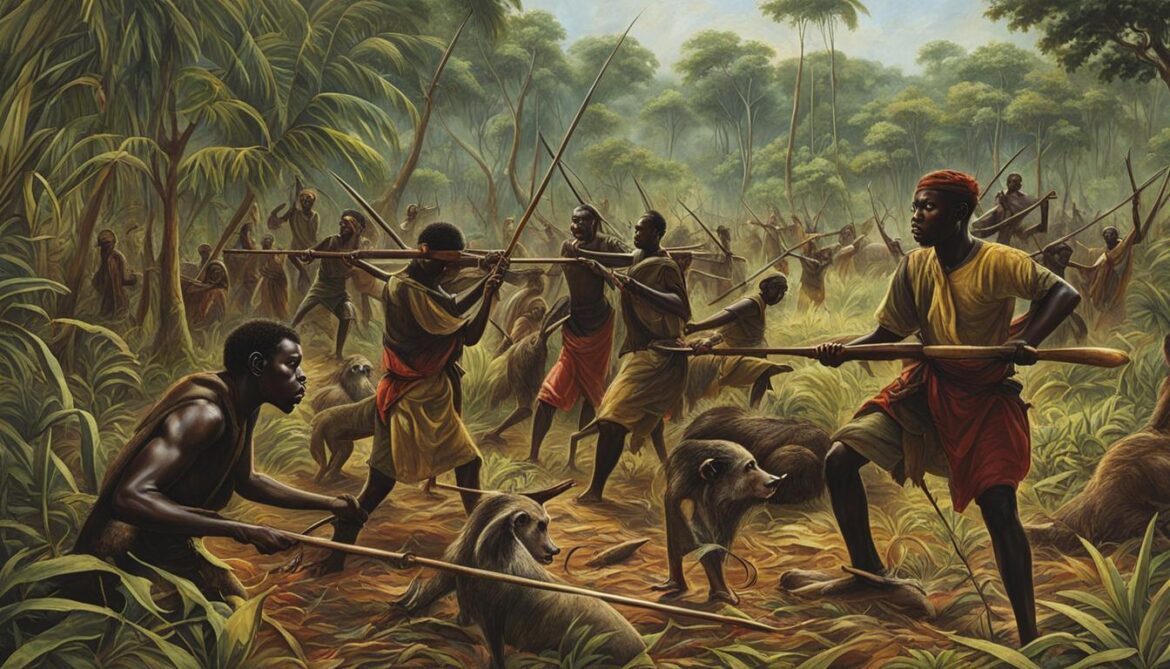
Threats to Biodiversity in Guinea: Logging and Fragmentation
Logging poses significant threats to biodiversity in Guinea, with illegal logging being a major contributing factor to forest fragmentation. Illegal logging activities are prevalent in Guinea, leading to the destruction and fragmentation of valuable forest ecosystems. This not only disrupts the natural habitats of numerous plant and animal species but also disrupts the ecological balance within these forests.
Small-scale logging companies often operate illegally, ignoring regulations and best practices, resulting in severe forest fragmentation. Forest fragmentation increases the vulnerability of flora and fauna by isolating populations and hindering their ability to disperse and migrate between habitats. This can lead to genetic isolation, reduced genetic diversity, and a higher risk of local extinctions.
Illegal logging activities are prevalent in Guinea, leading to the destruction and fragmentation of valuable forest ecosystems.
It is crucial to address the issue of illegal logging by implementing stronger enforcement measures and promoting sustainable logging practices. Reduced-impact logging, which involves methods that minimize damage to the forest and its biodiversity, should be encouraged and practiced by logging companies in Guinea. By adopting reduced-impact logging techniques, such as directional felling and proper waste management, logging can be carried out with minimal disturbance to the surrounding ecosystem.
Efforts should also be made to raise awareness about the importance of sustainable logging practices and the negative impacts of illegal logging on biodiversity. By educating local communities, stakeholders, and consumers about the consequences of illegal logging, it is possible to foster a demand for responsibly sourced and certified wood products.
Benefits of Reduced-Impact Logging
- Preserves valuable forest ecosystems and maintains biodiversity
- Minimizes habitat destruction and fragmentation
- Reduces soil erosion and the risk of landslides
- Supports sustainable livelihoods for local communities
| Threats | Logging and Fragmentation |
|---|---|
| Key SEO Keywords | logging, forest fragmentation, illegal logging, reduced-impact logging |
| Summary | Logging poses significant threats to biodiversity in Guinea, with illegal logging contributing to forest fragmentation. Small-scale companies often operate illegally and fragment forests, while few logging companies practice reduced-impact logging. Strengthening enforcement and promoting sustainable logging practices are essential for conservation efforts. |
By taking comprehensive action to combat illegal logging and promote sustainable logging practices, Guinea can protect its unique biodiversity and ensure the long-term preservation of its valuable forest ecosystems. Logging can coexist with conservation efforts through responsible management and enforcement of regulations, allowing both the local economy and the natural environment to thrive.

Threats to Biodiversity in Guinea: Overfishing and Habitat Destruction
Guinea’s marine biodiversity faces significant threats due to overfishing and habitat destruction. The practice of overfishing, especially through near-shore trawling and destructive fishing methods, has detrimental effects on the delicate balance of marine ecosystems in the region. The consequences extend beyond the depletion of fish populations, triggering a chain reaction that jeopardizes the survival of various species and habitats.
The problem is exacerbated by poorly regulated fisheries, allowing unsustainable practices to persist. The lack of strict regulations and monitoring enables the exploitation of marine resources without considering the long-term consequences. This unrestricted fishing activity jeopardizes the resilience of marine ecosystems, putting numerous species at risk of extinction.
Habitat destruction also plays a crucial role in the decline of Guinea’s marine biodiversity. Pollution from various sources, including coastal development, industrial activities, and agricultural runoff, pollute the waters and disturb fragile habitats. The accumulation of pollutants has a detrimental impact on the health and survival of marine species, further exacerbating their vulnerability to overfishing.
“We must prioritize sustainable fishing practices and stricter regulations to protect the delicate marine ecosystems of Guinea.”
Coastal development activities, such as the construction of ports and harbors, directly destroy habitats along the shoreline. This destruction disrupts the natural balance and connectivity of coastal ecosystems, affecting the survival of many species that rely on these habitats for reproduction and feeding.
- Trawling: A destructive fishing method that involves dragging a net along the seabed, causing extensive damage to marine habitats and species, including coral reefs and seagrass beds.
- Blast fishing: An illegal fishing technique that involves the use of explosives to capture large quantities of fish. This method not only kills the targeted fish but also causes widespread destruction to marine habitats.
If urgent action is not taken to address these threats, the marine biodiversity of Guinea will continue to decline at an alarming rate. Sustainable fishing practices, such as implementing catch limits and establishing marine protected areas, are vital for restoring and safeguarding marine ecosystems.
“It is imperative to prioritize the conservation of marine habitats and promote sustainable fishing practices to preserve Guinea’s unique marine biodiversity for future generations.”

Threats to Biodiversity in Guinea: Oil and Gas Extraction
Poorly managed oil and gas extraction in Guinea poses significant risks to the environment, resulting in pollution and habitat destruction. These activities have detrimental effects on the diverse biodiversity in Guinea, leading to negative socio-economic consequences and political implications.
Contamination from oil spills disrupts both land and marine ecosystems. Coastal areas, such as those off the coast of Ghana, suffer the brunt of this pollution, impacting marine species and habitats. The devastating consequences of habitat destruction are felt by various plant and animal species, many of which are already threatened or endangered.
Poorly managed oil and gas extraction in Guinea leads to pollution and habitat destruction, impacting biodiversity and causing socio-economic and political consequences.
It is crucial to implement sustainable practices and stronger environmental regulations to mitigate the threats posed by oil and gas extraction. By adopting sustainable extraction methods, the damage to habitats can be minimized, ensuring the preservation of Guinea’s unique flora and fauna. Additionally, stricter regulations will help protect the environment, safeguarding the diverse ecosystems that rely on the presence of oil and gas resources.
Sustainable Extraction Practices
Sustainable extraction practices focus on minimizing the environmental impact of oil and gas operations. These practices include:
- Implementing advanced drilling technologies to reduce spills and leaks
- Using environmentally-friendly drilling fluids
- Proper disposal of waste materials
- Rehabilitation of disturbed habitats
- Engaging in thorough environmental impact assessments
By adopting these practices, the negative consequences of oil and gas extraction can be mitigated, reducing pollution and habitat destruction. Furthermore, the implementation of sustainable practices can contribute to the long-term stability and sustainability of Guinea’s natural resources.
Environmental Regulations
Stronger environmental regulations are necessary to prevent and minimize the negative impacts of oil and gas extraction on biodiversity. These regulations should include:
- Mandatory environmental impact assessments for all oil and gas projects
- Strict monitoring and enforcement of pollution control measures
- Regular inspections to ensure compliance with environmental standards
- Punitive measures for non-compliance, including fines and penalties
- Strengthened collaboration between government agencies, industry stakeholders, and environmental organizations
By implementing and enforcing these regulations, Guinea can protect its biodiversity, minimize pollution, and promote sustainable development in the oil and gas industry.

| Threat | Impact on Biodiversity |
|---|---|
| Pollution from oil spills | Contamination of land and marine ecosystems, endangering plant and animal species |
| Habitat destruction | Loss of critical habitats, leading to the displacement and extinction of diverse species |
| Socio-economic consequences | Disruption of local communities and livelihoods dependent on natural resources |
Threats to Biodiversity in Guinea: Fuelwood and Charcoal Production
One of the major threats to biodiversity in Guinea is the unsustainable exploitation of forests through fuelwood and charcoal production. The heavy dependence on fuelwood in the country contributes to the ongoing degradation of forests and loss of valuable biodiversity.
As the demand for fuelwood and charcoal continues to grow, the environmental impacts become more significant. The continuous extraction of fuelwood for energy purposes leads to the depletion of forest resources and an imbalance in the ecosystem. The cumulative impact of this unsustainable practice puts immense pressure on Guinea’s forests and threatens the survival of numerous plant and animal species.
In addition to the direct impact on biodiversity, the trade in fuelwood and charcoal exacerbates the problem. The increasing demand for these products drives the unsustainable exploitation of forests, leading to further forest degradation. The large-scale production and trade of fuelwood and charcoal contribute to deforestation and the disruption of natural habitats, resulting in the loss of biodiversity.
To address these challenges and protect Guinea’s biodiversity, sustainable forest management practices are crucial. Implementing measures to regulate fuelwood and charcoal production, such as promoting alternative energy sources and advocating for responsible harvesting techniques, can help mitigate the adverse effects of this industry. By adopting sustainable practices, Guinea can ensure the long-term viability of its forests and protect the diverse range of species that call it home.
Impacts of Fuelwood and Charcoal Production on Biodiversity
The impacts of fuelwood and charcoal production on biodiversity in Guinea are far-reaching. Here are some key consequences:
| Impacts | Description |
|---|---|
| Habitat destruction | The extraction of fuelwood and production of charcoal contribute to the destruction of natural habitats, leading to the displacement and loss of plant and animal species. |
| Loss of keystone species | The unsustainable exploitation of forests through fuelwood and charcoal production can result in the loss of keystone species, which play crucial roles in maintaining the balance and functioning of ecosystems. |
| Disruption of ecological processes | Forest degradation caused by fuelwood and charcoal production disrupts important ecological processes such as nutrient cycling, pollination, and seed dispersal, affecting the overall health and resilience of ecosystems. |
| Reduction in biodiversity | The cumulative impact of unsustainable fuelwood and charcoal production leads to a significant reduction in biodiversity, as many species are unable to survive and thrive in degraded habitats. |
It is vital to recognize the ecological consequences of fuelwood and charcoal production and take proactive measures to address them. By prioritizing sustainable forest management practices and exploring alternative energy sources, Guinea can mitigate the negative impacts and preserve its invaluable biodiversity.
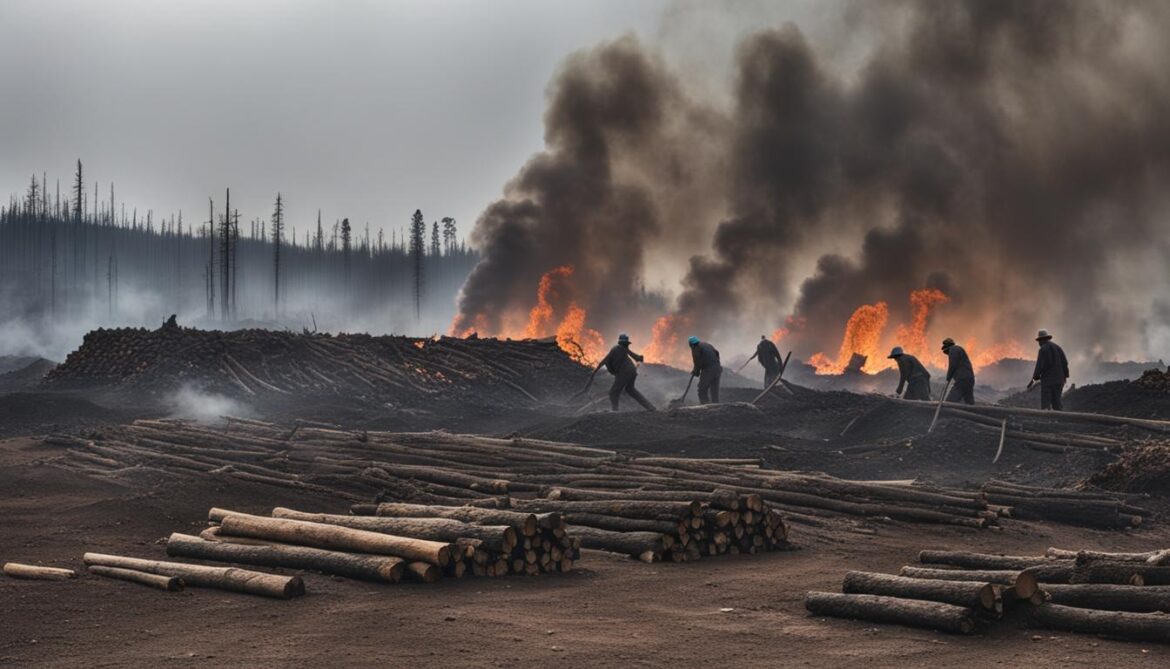
Threats to Biodiversity in Guinea: Mining and Geodiversity
Guinea’s mineral-rich areas attract mining activities, causing direct habitat loss and impacting both biodiversity and geodiversity. Mining, especially surface mining, leads to the destruction of forests and other habitats essential for species survival. The extraction of minerals exacerbates the threat of climate change and requires sustainable mining practices to mitigate environmental impacts.
To comprehend the extent of habitat loss caused by mining in Guinea, consider the following impacts:
- The clearance of large areas of forest for mining operations disrupts the natural habitats of numerous plant and animal species, resulting in direct habitat loss.
- Surface mining techniques, such as open-pit mining and strip mining, involve the removal of layers of soil and rock, destroying the topsoil and vegetation that support diverse ecosystems.
- The contamination of soil, water bodies, and air during the mining process negatively affects the health and functioning of ecosystems, further contributing to the decline in biodiversity.
Mining activities also pose a significant threat to geodiversity, which refers to the variety of geological features and processes within an area. Guinea’s mineral-rich areas contain unique geological formations and valuable resources, playing a crucial role in preserving geodiversity.
“Mining not only causes the loss of plant and animal species, but it also disturbs the intricate geological features that have developed over millions of years. Safeguarding geodiversity is vital for maintaining Earth’s natural heritage!”
Climate change is one of the most pressing global challenges today. Mineral extraction, including mining activities in mineral-rich areas, contributes to greenhouse gas emissions and aggravates climate change. The extraction and utilization of minerals require significant energy inputs, often derived from fossil fuels, leading to increased carbon dioxide emissions and environmental degradation.
Implementing sustainable mining practices is essential to mitigate the environmental impacts of mining activities in Guinea. These practices include:
- Adopting more efficient extraction techniques that minimize the surface area affected by mining, reducing direct habitat loss.
- Promoting reforestation and ecological restoration efforts to restore the habitats destroyed by mining activities.
- Implementing strict environmental regulations and monitoring systems to minimize the release of pollutants and mitigate climate change impacts.
Impacts of Mining on Biodiversity and Geodiversity
| Impacts | Biodiversity | Geodiversity |
|---|---|---|
| Direct habitat loss | Loss of diverse plant and animal species due to habitat destruction | Destruction of geological formations and features |
| Soil and water contamination | Disruption of ecosystem functioning and health | Influence on soil composition and water quality |
| Climate change exacerbation | Contribution to greenhouse gas emissions through energy-intensive extraction processes | N/A |
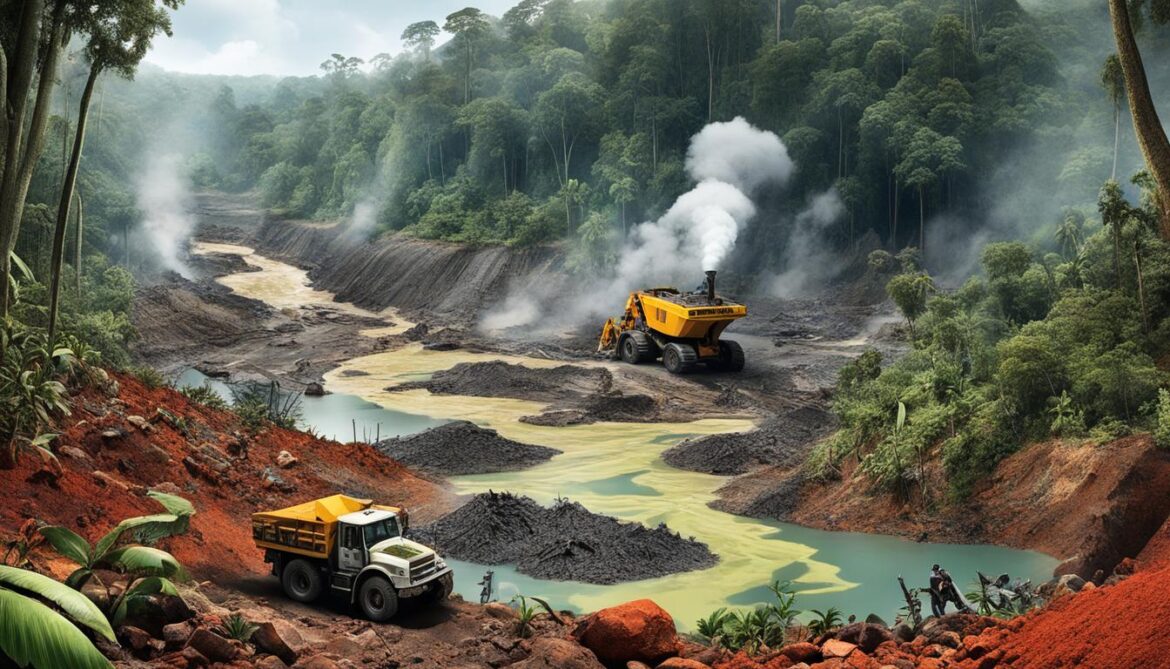
Threats to Biodiversity in Guinea: Climate Change and Pollution
While the impacts of climate change on biodiversity in Guinea may not be as extreme as in other regions, rising temperatures and sea level rise pose significant threats, particularly to low-lying coastal areas. Coastal areas are especially vulnerable to the effects of climate change, including sea level rise and increased storm surges that can lead to the loss of critical habitats and species.
Climate change also exacerbates existing pollution issues, further endangering biodiversity in Guinea. Pollution, such as sedimentation from deforestation and agricultural runoff, is a major concern for freshwater habitats and species. Sedimentation can disrupt the delicate balance of aquatic ecosystems, affecting the health and survival of freshwater species.
“The combined impacts of climate change and pollution are putting immense pressure on Guinea’s biodiversity. We need to take urgent action to address these threats and protect the unique ecosystems and species that call Guinea home.”
Coastal Areas: A Critical Habitat at Risk
The coastal areas of Guinea are valuable ecosystems that support a diverse range of species, including migratory birds, marine mammals, and diverse marine flora and fauna. However, these areas are particularly vulnerable to the effects of climate change, such as sea level rise and increased storm intensity.
Sea level rise threatens to inundate low-lying coastal areas, leading to the loss of important habitats like mangroves, salt marshes, and seagrass beds. These ecosystems provide crucial breeding grounds for various species and act as natural buffers against erosion and storm surges.

Pollution: A Growing Threat to Freshwater Habitats
Alongside climate change, pollution poses a significant threat to freshwater habitats and species in Guinea. Sedimentation, resulting from deforestation and agricultural runoff, can have detrimental effects on the health and biodiversity of freshwater ecosystems.
Excessive sedimentation can smother aquatic vegetation, disrupt food chains, and degrade water quality, affecting fish populations and other aquatic organisms. It also reduces the amount of light penetrating the water, inhibiting photosynthesis and further impacting the health of freshwater habitats.
Addressing the Challenges: Biodiversity Conservation Strategies
To protect Guinea’s biodiversity in the face of climate change and pollution, comprehensive conservation strategies are essential. These strategies should include:
- Implementing measures to mitigate and adapt to climate change, including reducing greenhouse gas emissions and enhancing ecosystem resilience.
- Developing and enforcing regulations to control pollution from various sources, such as industrial activities, agriculture, and urban development.
- Adopting sustainable land and water management practices to minimize sedimentation and other forms of pollution.
- Protecting and restoring critical habitats, such as mangroves, salt marshes, and freshwater ecosystems.
- Increasing public awareness and engagement in biodiversity conservation efforts, promoting the value of ecosystems and the importance of sustainable practices.
By implementing these strategies, Guinea can work towards preserving its unique biodiversity and ensuring the long-term survival of its precious plant and animal species.
Conclusion
Efforts must be made to address the threats facing Guinea’s biodiversity and protect its rich flora and fauna. Conservation efforts are vital to preserving the unique species that call Guinea home.
By implementing sustainable ecosystem management practices, we can ensure the long-term survival of these valuable ecosystems. This includes protecting and restoring habitats, promoting biodiversity-friendly agriculture, and reducing pollution.
Furthermore, the promotion of ecotourism opportunities can provide economic incentives for local communities to support conservation initiatives. By creating sustainable tourism experiences that respect the environment and local cultures, we can generate income while preserving the natural beauty of Guinea.





